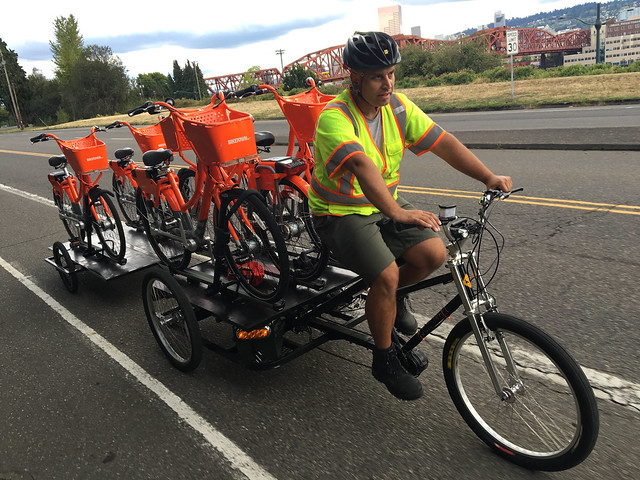
Biketown is now using bikes to refill bikes at bike share stations. Makes perfect sense right?
Yesterday we scored a sneak peek at a new program that the City of Portland and Motivate (the city’s bike share operator) is working on: A small fleet of pedal-powered trikes that will help make sure Biketown stations have enough bikes available to potential users. In the bike share world this task is called rebalancing.
As bikes get used and left around town, some popular stations tend to run out of bikes. It’s a tricky issue for all bike share systems, and a costly one. Rebalancing is the single largest operational expense for bike share systems. Operators of Washington D.C.’s Capital Bikeshare spend about 55 percent of their operating costs on rebalancing efforts which includes the wages of 20 van drivers and four dispatchers (we rode along with one in 2013).
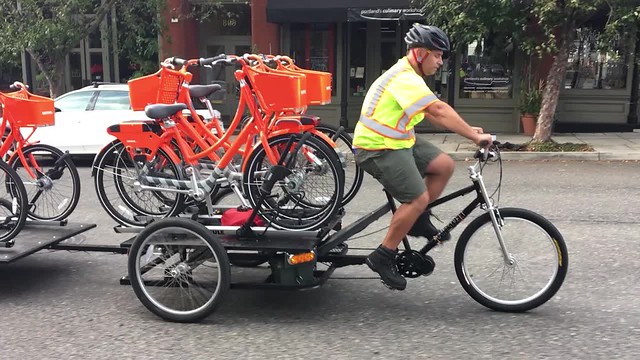
But Portland’s system is different. Our “smart bikes” have on-board technology and don’t have to be parked at a Biketown station. This takes pressure off the operator to make sure stations have spaces to return bikes and bikes to use.
Instead of relying on costly vans and a dispatch system, Biketown is using real-time GPS data and financial incentives (users can get a $1-2 account credit for returning bikes to stations, see tweet below) to keep the system balanced. Now they’ve added a few cargo bikes with trailers to that effort.
As we reported last year, the Portland Bureau of Transportation’s bike share program manager thinks our system’s flexible parking feature will elimate half of the rebalancing costs.
#BIKETOWNBOUNTY Hey, Sellwood-Moreland friends. Return bike 0830 to a Priority station for a $2 acct credit. pic.twitter.com/rXurP9gepH
— BIKETOWNpdx (@BIKETOWNpdx) July 28, 2016
Advertisement
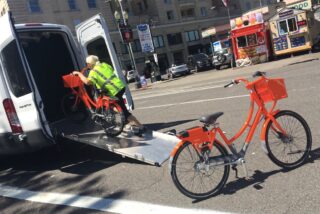
The city wants to keep the system balanced in order to get more customers. And the system operator Motivate is required by their contract with the City of Portland to “increase the probability” that stations never sit empty and to have no fewer than 10 percent of the 1,000 bikes in the system in each quadrant of the city at any given time.
Yesterday was the first time their new trike hit the streets. According to a PBOT spokesperson what we saw was part of a test and the full program is ready for prime-time just yet.
Here’s what we do know about the trikes so far:
– Biketown will use them for rebalancing and to respond to bike service and repair requests.
– They will complement vans already in use.
– The one we saw yesterday was made by Main Street Pedicabs, a Denver-based company.
– They have electric assist and can pull two trailers and up to six fully-assembled Biketown bikes (compare that to a van which can hold about 15-20 bikes).
– The trike and trailer has a cool, working turn signal!
One question looming among insiders is whether or not we’ll see the Portland-made “Truck Trike” used by Biketown. This cargo trike is made by southeast Portland based Stites Design and has already been shipped to New York City for use in its Citibike program.
We’ve reached out to Stites Design and PBOT to ask about the Truck Trike and will update this post when/if we hear back.
UPDATE, 11:20 am: We’ve heard back from Bill Stites of Stites Design. He confirmed that he wasn’t asked to bid on the contract. According to Stites, his Truck Trikes are heavier duty than what’s required for Biketown. The Stites trike can canb carry 600+ lbs. of cargo plus 200 lbs. of driver. This capacity is way more than what’s needed for Biketown and as a result the price of Truck Trikes is more than Motivate needed to spend. For Biketown, Motivate decided to go with a smaller capacity trike from Main Street (which Citibikes in NYC is using too). Stitles says he’s glad to see the city using trikes, “even if they aren’t Portland made.”
— Jonathan Maus, (503) 706-8804 – jonathan@bikeportland.org
BikePortland is supported by the community (that means you!). Please become a subscriber or make a donation today.



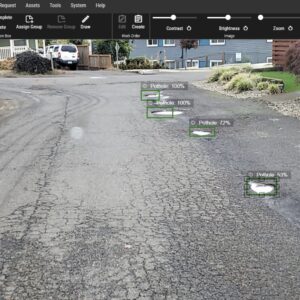
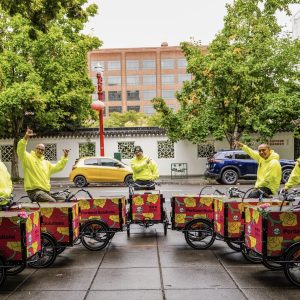
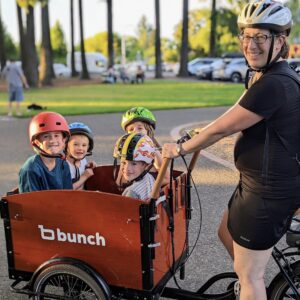
Thanks for reading.
BikePortland has served this community with independent community journalism since 2005. We rely on subscriptions from readers like you to survive. Your financial support is vital in keeping this valuable resource alive and well.
Please subscribe today to strengthen and expand our work.
what’s the need for this if the vans are faster and have more cargo space? are there places where BikeTown isn’t accessible via van?
Joke, right?
remember, this is Nike we’re talking about… they’ll take the cheapest available option…
I want to know all the incentives that this trike brings that make them think this is a money-making endeavor…
sure, it’s the right thing to do, which is why I question why Nike is doing it…
Nike only paid to slap their logo on all the bikes. They are not operating the system nor are they involved in any planning.
for some reason I thought they were responsible for half the operating costs…
Because bikes are cool?
I can imagine several advantages:
– Vans cost more than e-cargo bikes. Aside from initial purchase costs, I imagine gas/maintenance are quite a bit higher with vans.
– Additionally, it might cost more to pay for a commercial driver than a commercial biker (licensing, insuring, etc.)
– While vans might have a larger capacity, they may take longer to park/load/unload than a cargo bike. While the large capacity might make sense for some use cases, I can imagine there are certain parts of the city where being able to quickly pick-up and drop-off smaller number of bikes is more efficient.
– There’s also the externalities of carbon pollution with each van’s combustion engines, which is definitely a cost, though one most organizations feel comfortable placing on the shoulders of the general public. Perhaps the Biketown folks care about the environment and running an ethical business. Imagine that.
– There’s also just the optics of using bikes to manage a bike sharing system. The medium is the message. I think it’s a great message!
I know that, at least for Trimet, the #1 operating cost is the driver. I would be interested to see the cost breakdown of both options, including driver, measured on a bike-mile moved per hour basis.
Bikes don’t have to be insured for liability in the event of a collision, but motor vehicles do. Transport with the van, isn’t necessarily going to be faster than with the trike, or not much…depends on area being served, traffic, etc.The difference in pay received, between the van driver and trike, would be interesting to know.
For some, but maybe not all bike share re-balancing needs, three trikes basically can do the bike share re-balancing that a single van can, possibly for less money. Lots of people need work, and I’m in favor of creating more jobs. Unless the numbers say that trike re-balancing falls considerably short of good cost efficiency, this seems like a really good way to get the job done.
Glad you mentioned Bill Stites’ model. That was the first question that came to mind when I saw this.
Delighted to see the operators moving in this direction. I’ve long thought it incongruous to have big vans driving bikes around within the context of bikeshare. We had some conversations about this here a few years back. Thanks for the report!
Or… pay a stipend to someone (a group of someones) out of work who live close to these stations to rebalance them. And I realize you’d need to pay someone to coordinate these employees.
The question I have (& had back in 2013) is what is the full cost to rebalance the fleet per average bike using
(a) van
(b) cargo bike/trailer
(c) incentivize members to do this
(d) pay houseless person stipend
(e) …
I would make an estimate on the following numbers –
$32k for a Sprinter van – 20 bike capacity, 1 person’s wages paid.
$5k each (my guess) for bike and trailer – 6 bike capacity per 1 person’s wages, and consider longer trip times.
So, to move the same number of bikes, the van wins for cost efficiency even if it loses on capital cost. This is because, at the very least, human labor is significantly more costly than gasoline.
Yeah, I’d like to see some numbers that go about three levels deeper than this. This was studied a few years back (link in the article above). But I seem to remember that (at least in my interpretation) those doing the study and writing their recommendations weren’t being quite as creative as they could have been in finding ways to justify the bike-balancing-by-human-power part.
Assuming that there is a need to move 20 bikes at one time. If balancing is more often needing to move 1-6 bikes then the trike has the same capacity as the van. 20 bikes is a whole stations worth. It seems unlikely they would ever be wanting to drop more than 10 bikes at any one place.
>It seems unlikely they would ever be wanting to drop more than 10 bikes at any one place.
A van might be more efficient when they want to collect five bikes from four different full docks downtown then leave five bikes at four different empty or almost empty docks north of Skidmore. A lower capacity and slower cargo bike might take much longer to accomplish the same movement. It can make sense to have both in the fleet.
I don’t think relying on the users works… car2go stopped letting people get a 15 minute credit for fueling up low vehicles…
however, if I call to report an illegally parked car2go they’ll ask if I can move it for them for a 15 minute credit…
so perhaps if you had a way in the BikeTown app to highlight bikes that needed to be moved then you could rent them for free (or a 15 minute credit) to take them where the app wants them… all you would need is a person to take it to the next station, then another person to take it to the next station if that person couldn’t take it all the way, etc etc until the bike gets to where they want it…
Exactly.
There are no doubt a very large number of ways to creatively solve this problem, especially if this were an open competition for ideas.
But I suspect we would quickly come up against a bean counter who had already figured on, e.g., 7 employees and three vans to operate this system, and if we figured out a way to eliminate five of the employees and the vans, because we found a way to crowd-solve the rebalancing problem then we’ll see pushback most likely couched in terms of efficiency, related to the upstream investments and budgets and all that would be involved in backing out of those commitments. Which is why it would be nice to see creativity earlier on in the design and setup of these contracts.
How would the stipend work differently from incentivizing members? Maybe a company-provided phone or some way to get tasks from a kiosk, better pay than the $1-2 bounty, and a free bus pass?
Gasoline is “free”, so the main factor vs the trike is the driver’s time. If the van is stuck in traffic, the trike could easily be more efficient at least until the bike lane ends or is blocked by a van. It looks like the trikes would be easier to load, so they will come out ahead wherever moving 3-7 bikes was a typical load. Do the vans not do multiple pickups and drop around 15 bikes at one location?
But I question all of that weight of 2 trailers to move 4 things with wheels. Some kind of tow bar off the back of a longtail electric cargo bike could probably do as well or better if you could lean in turns. Or a tow rig to drag 2 bikes behind the trike with 3 on top — same number of wheels on the ground save 2 when empty, but it would be harder to make-up time with the trike running empty vs an empty longtail.
I’m disturbed by the rider’s helmet in that picture. It’s like seeing someone push a hand truck with a race helmet on. 1. I can’t believe it will/should go over 12mph. He’s not wearing any elbow or knee pads. 2. If he goes over deltaways with 150lb of bikes raining down behind him, he’ll need a much bigger helmet.
Is 6 a typo? 2 trailers with 2 bikes each and 3 bikes on the trike makes 7.
Props for the creative effort.
Great idea! I’m glad they’re giving it a try.
Will be interesting to see how this works out. I’m a bit skeptical that using bikes to move around bikes wouldn’t be crazy inefficient even if it sounds cool.
The bounty system sounds a lot cheaper, but that presumes they can find enough people to do it — migration is a function of where people want to go from/to. Having said that, I could see returning bikes and jogging from the priority stations as a way to earn a few beers for getting some exercise.
“using bikes to move around bikes wouldn’t be crazy inefficient even if it sounds cool.”
Wouldn’t the challenge then be to tweak things so either
(a) using bikes ceased to be (perceived as) inefficient, or better yet
(b) interrogate how we’re measuring efficiency. If efficiency suggests the van wins I’m pretty sure we’re doing it wrong. Ivan Illich strikes again.
Cost-efficiency, of course. The operator may be the #1 cost, so the focus should be on how to most efficiently use their time.
>The bounty system sounds a lot cheaper, but that presumes they can find enough people to do it
If they gave a credit for rebalancing, then you could rebalance a bike or walk a few blocks further to a bike not at a dock once every two or three days and the system would be free for you. It would be like a bike share coop.
This presumes that stations with “excess” bikes are near the ones that lack bikes.
I don’t know what the actual patterns are, but I would expect something more along the lines of entire areas that lack or contain excess bikes. I’m sure plenty of people will walk a few extra blocks for a buck or two, but I suspect the vast majority of these bikes need to go significantly further.
That also presents a challenge for trike rebalanced bikes. Aside the amount of time it takes to pedal a heavy trike towing very heavy trailers loaded down with hundreds of pounds of bikes, the trike must be pedaled to another area with “too many” bikes before it can drop off another load.
I presume enough bikes can be moved short enough distances for the trikes to make sense, but even trikers paid minimum wage will cost quite a bit per bike that is moved.
If you had a bus pass and would otherwise be collecting cans for extra cash, it would seem this might be a nice way to make a few bucks, even if you had to ride a couple of miles.
We’ll never know until we try!
Don’t forget you get a credit rather than actual cash. Also, even with the bus pass, this would be really, really slow — maybe one of the few ways of raising money that’s actually slower than collecting cans. Going to a bounty bike, delivering it, and getting to where you actually want to be (maybe another bounty bike) is probably going to take about an hour if distances over a mile and the bus is involved. On foot, you could probably beat the bus the vast majority of the time.
It’s possible that offering bounties might actually *lose* money. People headed near priority stations are going to jump on this so what would have been a normal trip now results in a credit for them. I can imagine a few people doing it for fun which works out great for everyone. But it’s worth a shot — anything that works is a good idea.
I’d offer cash, not a credit.
If someone racks up enough credits can they just take one of the bikes?
Seems to me that if they get the bugs worked out of their tracking system, they could build some limited rebalancing into the bounty system: $1 credit to take a bike from a station that is full or almost full (say, only one or two open racks); $1 credit to return a bike to a station that is empty or has only one bike. It might encourage some regular riders to shift the beginning or end of their trip to a nearby station and walk a few extra blocks to pick up a credit on their account. Just make sure the system is smart enough to keep people from gaming it (riding the same bike back and forth between a full and empty station to keep piling up credits, for example).
About time. The way that bike share stations are clustered and the fact that they have enough extra space for a trike with a trailer at nearly all of the bikeshare stations, the trikes make sense, I have heard a lot of complaints that the vans have a tendency to block traffic in the area of the parking for bikeshare. The trikes are a much better idea.
neither vehicle can be used for direct access to bus-mall stations…
can’t park a van on the bus-mall and can’t ride the trike on the sidewalk…
they must be manually walking the bikes from a nearby parking spot while using the van…
Cool idea! A great way to show the general public (who seem to be embracing Bike Town as a cool way to easily get around) that bikes can do more than just transport you and a small bag.
Related to re-balancing, before the last home Timbers game, I noticed that there was a van at the station in front of the stadium, opening room on the rack as fast as people rode up, but they didn’t do the same after the game. Seems like if, say, 50-100 people took bike share to the match, there’s an expectation that the same amount of people should be able to take bike share home. But maybe the bike share folks know something I don’t… or the van was on its way with a fresh batch of bikes.
Overall, I can say I’ve been super impressed with bike share in Portland. Hopeful that it keeps up the popularity once the weather gets wetter.
What they did in Vancouver during the mural festival was set up a temporary bike share station that was similar to a bike valet.
Maybe something could be set up temporarily for big events like this.
This is the most awesome thing I’ve seen about BikeTown.
Another idea for rebalancing might be to give people a (small, say, $1) cash payment for riding bikes from surplus areas to deficit areas, similar to the bonus for moving a bike that is out of a station back to a station.
I don’t disagree that some would approach it in this manner. All I’m saying is that there is a lot more to it, and being creative as opposed to dogmatic (Neoclassical Economics Professor) about it could yield some interesting and perhaps even surprising insights. As others have said (or implied) this isn’t just another public transit option: it is about human locomotion. To (figure out how to) keep the fossil fuels at arm’s length seems like a no-brainer.
>As others have said (or implied) this isn’t just another public transit option: it is about human locomotion. To (figure out how to) keep the fossil fuels at arm’s length seems like a no-brainer.
If the cost of keeping biketown as pure and untainted by motor vehicles as possible is to increase operating costs and reduce (or slow) system expansion, is it worth it? Would using a van for some rebalancing acts be more acceptable if the lower operating costs helped to facilitate a larger biktown network than restricting use to cargo trikes, and that system expansion helped to facilitate a larger number of people getting around by bike instead of car, reducing the number of vehicle miles traveled? And if the ICE van is replaced with an electric one in five or ten years, does the issue go away?
“If the cost of keeping biketown as pure and untainted by motor vehicles as possible is to increase operating costs and reduce (or slow) system expansion, is it worth it?”
You are making the presumption that with full cost accounting it would be. I’m less certain, especially given some of the great optimization suggestions being floated here.
“Would using a van for some rebalancing acts be more acceptable if the lower operating costs helped to facilitate a larger biktown network than restricting use to cargo trikes, and that system expansion helped to facilitate a larger number of people getting around by bike instead of car, reducing the number of vehicle miles traveled?”
I guess that would in part depend on the objectives of this system. Seems like a great subject for a larger public conversation (a version of which we are already engaged in right here). I’m not proposing to decide how this should be handled but I am pointing out some of the ways we might think about this to do a better (less fossil fuel dependent) job.
“And if the ICE van is replaced with an electric one in five or ten years, does the issue go away?”
Powered by what? Folks here love to throw out electric propulsion as if this made all the difference, eliminated the fossil fuels. It is (as I am sure you know) quite a bit more complicated than that.
Powered, no doubt by the same thing that powered the factory that made the steel for the human locomotion machines.
Your larger point: we are stuck with a fossil fuel drenched economic system is of course valid, but the stock vs. flow distinction seems important to me. Let’s say the barrels of oil equivalent required to manufacture and ship and maintain a cargo trike and trailer = X; are you really suggesting that the barrels of oil equivalent required to manufacture and ship, FUEL, and maintain the electric sprinter van are equivalent? Because my hunch would be that we’re off by an order of magnitude (or even two).
I think Bill Stites has a handle on this LCA comparison. Perhaps he will chime in?
I’m suggesting that things are, as you say, complicated.
We heard back from Bill Stites of Stites Design about his Portland-made Truck Trike and just posted this update to the story:
Using bikes to move bikes. Makes sense, and sends a message, too. Saw the video on Facebook yesterday. Thinking outside the box! Great idea!
Nice job, BIKETOWN. I was very pleased to see the rebalancing happening this way.
Who makes “Main Street” trikes?
It looks like they are out of Denver area? With other local trike folks such as Ryan Hashagen of Portland Pedicabs and Icicle Tricycles?
http://icetrikes.com/frequently-asked-questions/
ughhh… wish I could edit my post. 🙂
I mean to say What about other local trike folks such as Ryan Hashagen, et. al.?
I think there needs to be a task force to evaluate all possibilities. Start with a new logo and establish goals and objectives and performance measures. Then take expensive trips to exotic locations to see how they do it. That’s the Portland way.
ha ha! Nice one, J_R. touché.
Awhile back, discussion of a bike corridor on NW 13th (for me) evolved into the possibility of dedicated trike lane widths there and at specific cross streets – Flanders, Madison? From these beginnings, where would trikeways logically extend? The Waterfront, the Park Blocks. How would rickshaw rides fit in?
In my experience this move is almost entirely based on optics and really won’t provide a big lift when it comes to rebalancing. Unless they are putting a dozen of them on the road, which I doubt.
The discussion of using bikes comes up in almost every city and eventually gets dismissed as not worth the effort operationally, but a great investment from a marketing perspective.
We generally put GPS in our trucks for fleet management purposes and using that data you can determine pretty easily if a bike would be more efficient than a truck and the answer was always no.
The article states the trucks hold 15-20 bikes which in my experience is way under what the larger sprinters can hold. We typically put 25-27 in the large Sprinter. Motivate may be saving money by using a Ford Transit or Nissan NV that isn’t as big.
The article also states they’ll be using them for service/repair. Which means they won’t constantly be in motion rebalancing, sometimes they’ll just be dealing with repairs. They’ll likely also be used to bring bikes back to the warehouse that can’t be repaired on the street.
Sending staff out to rebalance or repair bikes by bike is definitely cheaper and greener than using sprinters and transit vans but it’s much less efficient. Given that Motivate has no service level penalties that can be levied against it the cheaper option is always going to make more sense for them.
Motivate hasn’t mentioned how many rebalancing vehicles it has, what time frames the vehicles are in use or produced any numbers about how many stops have been made or bikes moved. This is generally information systems who are well staffed love to talk about but systems who are under staffed don’t mention.
The only way the bikes are more efficient than trucks is when traffic is really bad, like Manhattan at rush hour bad, and the traffic here is never like that.
I think this needs to be clarified “As we reported last year, the Portland Bureau of Transportation’s bike share program manager thinks our system’s flexible parking feature will elimate half of the rebalancing costs.” In the report from last year Hoyt-McBeth said ‘half the rebalancing needs’ NOT half the rebalancing costs.
There is not a 1 to 1 ratio of rebalancing stops to rebalancing costs. The costs generally go down ‘per stop’ or ‘per bike’ as you do more and more rebalancing. Needing to make half as many stops or move half as many bikes doesn’t cut your costs in half.
“We generally put GPS in our trucks for fleet management purposes and using that data you can determine pretty easily if a bike would be more efficient than a truck and the answer was always no.”
See, now we’re talking. What I’d be inclined to do:
put GPS on our bikes, I mean trikes, and using that data you can determine pretty easily if a truck would be more efficient than a bike and the answer was expected to always be no.
“Sending staff out to rebalance or repair bikes by bike is definitely cheaper and greener than using sprinters and transit vans but it’s much less efficient.”
I’m curious, since you obviously have some knowledge of this operational question, how are you measuring efficiency? I ask because efficiency is one of the slipperiest concepts we know. Everyone uses it to justify whatever the hell they want it to mean, to make their policy preference look better. On it’s face, energetically, a bike is widely understood to be more efficient than even walking. But of course we are dealing here with more than just energetics. But perhaps you’ll humor me and set me straight? Thanks DQ.
You are right about different definitions and I should be more specific.
Let me say first that if Motivate simply cannot afford trucks/drivers and they can afford trikes there’s absolutely nothing wrong with using this method. It’s a net positive vs doing nothing.
Lets start with the simple idea that a rebalancing drivers job is to move bikes. Assuming we can agree on that, we could then define efficiency as the number of bikes moved per dollar of cost for that drivers shift.
Once we figure that out we could compare that to the number of bikes moved per dollar of cost for a ‘driver’ using a trike.
Using very generic numbers here:
lets say in an 8 hour shift a driver can make 32 stops or 4 stops an hour. The driver can pick up or drop off up to 20 bikes (the number in my experience is much higher but i’ll go with the articles number). So a driver is capable of moving 40 bikes an hour. or 320 per shift.
Let start with an assumption that the trike can move just as fast as the van. They can move 6 bikes per stop so they can move 12 bikes per hour. Or 96 per shift.
If you pay a ‘fully loaded’ (meaning wages and benefits) wage to a van driver of $45 an hour and the trike driver $30 an hour the math works out to $2.50 per bike move for the trike driver and $1.13 for the van driver.
You can add in fuel and it gets closer of course. But if you say the driver has to drive an average of say 2 miles per trip he’s only driving 64 miles a day. So even with low fuel efficiency we are only talking 5 gallons of gas. Add another $20 to the cost of the van to be generous. You can also add in insurance, GPS, maintenance costs, etc. It still won’t get up to the same cost per bike move as using the trike.
And when you reach the end of that analysis you have the additional basic fact that you can simply move over 3 times the # of bikes with the same amount of staff.
Now of course you have the initial cost (and/or ongoing lease costs) of the vehicles. However that comes from an entirely different budget generally that your day to day operations costs and salaries.
There is the question of “What if you just don’t need to move 300+ bikes a day?”
That’s a valid question, and you see some systems using smaller vans (A Nissan NV vs a full size Sprinter) because the capacity is just not needed. The thing is that rebalancing is basically a never ending battle. It’s generally pretty easy to come up with metrics that show you what the optimal number of bikes is for ever station (or area) at any time of the day for that day of the week.
So even when stations aren’t full or empty, there’s always stations that aren’t stocked optimally or an event that’s about to start/end. You can just ignore it (especially when the client won’t care or has no recourse to penalize you) or you can be proactive in optimizing the inventory.
Separate from the efficiency question the vans have other benefits. Drivers can lock up a van and go do something else (have lunch, help a customer, run some sort of errand as part of their job) and all the bikes are safely locked up. The trike driver would have to lock each bike separately to the rack or unload them and lock them to something.
A van can hold and power laptop or tablet, allowing the driver to view real time information and make better decisions on their own. Some systems have laptops in each vehicle, some rely on a dispatcher. The vans can also contain GPS units for fleet management, which can provide great metrics and help with training and driver optimization.
It can hold lots more spare parts than the trike. As well as other supplies like products to clean graffiti.
And the fact that the van has air conditioning is a perk the staff are going to appreciate vs pedaling a trike around in sometimes uncomfortable weather. This is especially a factor if the system wants to hire drivers with a CDL. In my experience the CDL drivers want a job that involves 99% driving and little else. Hopping in and out of the van to load/unload bikes generally isn’t something they want to do.
Sorry for the rambling post, I like bike sharing and I like to talk! And I do have a background in bike sharing, I’ve been involved with 9 different bike share systems in some capacity.
And again, i’m not anti Motivate. If anything I’d call them out only to push them to do better so BikeTown can be better.
D
Extremely helpful, DQ. Thank you very much for taking the time to explain all of that. Lots to think about.
I agree, DQ! It’s so nice to have an educated, experienced, well informed voice in these discussions! Thank You!
Thanks for that. What I’m wondering is whether there are 20 bikes to be loaded from one location, or if locations with surplus bikes are aligned such that it makes sense to collect 5 each from 4 stops and then drop them at one or two. Or, bikes are more scattered and you spend more time on a loop to collect a truckload, plus maybe need to drop them at 4 different stops? Taking 20 bikes from one station to another twice per hour seems too tidy. How much time is spent loading per-stop (parking, tailgate, etc) vs per-bike?
Needing to pick up 20 bikes at one station and needing to pick up 5 bikes from 4 stations are both realistic situations. In my example I was trying to show the value of the higher capacity so I used an example for a rebalancer moving lots of bikes. Even if the driver wasn’t moving 20 at a time, but was moving say 10 at a time, the value of the van is still higher.
In your hypothetical, picking up 5 each from 4 stops and dropping 20 at 1 (or 2) the van creates more value as well. If you want to pick up 5 from 4 stops in the van you just make 4 stops and pick up a total of 20 bikes. Then you take them and drop them at once (5 total stops). If you want to do this same thing with a 6 bike capacity trike you have to pick up 5, then drop off 5, and repeat that 4 times. So you have to make 8 total stops.
As far as parking and loading bikes I can’t say how fast/slow the trike is but I can tell you the drivers get really fast at loading the trucks. The trucks are fitted with a hydraulic ramp and the drivers typically wheel them in 2 at a time.
One thing I have noticed so far by peeking at the Biketown map is that the system hasn’t really taken off as a commuter option yet. Not to say nobody is using it to commute (nor saying the system isn’t doing well, it is). The fact that it’s not seeing big commuting numbers definitely eases the rebalancing needs because it reduces the big ‘one way’ flow of bikes that the commutes to downtown can create.
Since I think this whole system is tracked via fancy computer, why not marry the unbalanced fleet problem to a congestion pricing model, whereby at any particular moment, bikes at each station are valued on a scale that reflects their degree of out-of-balancedness. This information is public, and any member would, in this scenario, receive an electronic debit or credit proportional to the distance this bike needed to be transferred.
You’d figure out the pricing (scale) by dividing the life cycle cost of the rebalancing infrastructure now in place (and that you could skip under this regime) by the number of bikes that are deemed to need rebalancing, e.g., per year. If it turns out that kids or homeless people with lots of time decide to learn the finer arts of rebalancing and solve the problem as shoestring fleet managers, so bet it.
Ideas like this have been discussed a ton, they are not bad ideas and mathematically they work.
The issue though is that rebalancing has to be dependable, you have to know it’s going to happen every day of the week, on holidays, when it rains, when it’s 100 degrees. So you can’t launch a system without having a rebalancing infrastructure ready to go and ready to pay for and hope that your ‘member rebalancing’ program does the trick.
Plus getting homeless people to be members (most systems require a debit/credit card) is a tough sell. Kids could be a good option in the summer time at least.
We’ve tried member rebalancing projects in the past.
http://www.thewashcycle.com/2011/05/cabi-introduces-reverse-rider-rewards.html
They’ve produced interesting results, but nothing that makes an impact big enough that you could make you confident that member rebalancing could replace operator rebalancing.
This from a comment in below the article you linked:
>>> The name is a misnomer. A “Rewards” program usually provides a per-activity incentive that is guaranteed. This is really a “contest” or “competition,” with little hope of a payout — and thus, little incentive — for a casual user that might occasionally be free and able to reposition a bike. <<<
Perhaps a real credit/payment scheme would have better results?
“The issue though is that rebalancing has to be dependable, you have to know it’s going to happen every day of the week, on holidays, when it rains, when it’s 100 degrees. ”
And my suggestion—to have a congestion pricing model help you crowd source this effort—should be able to handle this. You just need to not cap the financial reward for those tricky times to get your public to rebalance these for you. A dynamic pricing algorithm should be able to accomplish this.
It would be cheaper to have someone do the work than to pay out a series of high “uncapped” financial rewards for having customers rebalance.